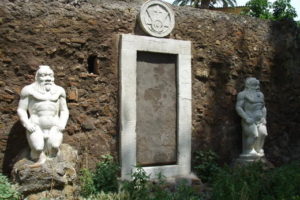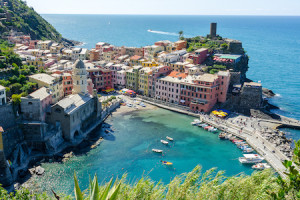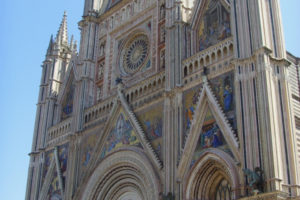Easter in Italy is one of the most exciting times of the year. From cities to small towns, traditional celebrations are the main order of the weekend. Be it the religious ceremonies in Rome, exploding carts in Florence, racing statues in Abruzzo, or cheese-rolling in Umbria, there’s something to enjoy for everybody.
Here we’ve made a small selection of the main events, plus some unique festivities that are definitely worth catching. So if you’re planning to travel to Italy during Easter and would like to experience any of these, contact us and we can help you have the perfect trip.
Rome
Rome is the heart of the Catholic Church, and as such is the destination for many pilgrims for the Easter weekend. Some may believe that this makes the city very crowded, but it’s actually not too busy – certainly not as much as in the high season of June and July.
The Easter celebrations begin on the evening of Good Friday, when the Pope visits the Colosseum for the Via Crucis – the Way of the Cross. This procession of the Stations of the Cross begins inside the Colosseum, but then makes its way outside, where the crowds gather to catch a glimpse of the Pope. It’s a good way to see the traditional pomp and ceremony of the Catholic Church.
On Easter Sunday, there is another opportunity to see the Pope, as he gives Mass in St. Peter’s Square at the Vatican. After saying Mass, he will ascend to the balcony of St. Peter’s Basilica to give the Urbi et Orbi (The City and the World) blessing – one of only two times a year he gives this, the other being Christmas Day.
Apart from the Vatican Museums, which are closed on Easter Monday, and the Colosseum (closes early on Good Friday) all the major attractions are open as per their usual hours. However, some shops and restaurants are likely to be closed on Easter Sunday and Monday.
Florence
Florence is a fabulous city at any time of year, and is never short of unique traditional events. These events often have roots that are hundreds of years old, and have changed little down the centuries. Easter Sunday is no different, and has possibly the most exciting of these spectacles.
The Scoppio del Carro, or Burning of the Cart, is a tradition that dates back to the First Crusade in 1097. A Florentine, Pazzino de’Pazzi, was the first man to scale the walls of Jerusalem, and was gifted three pieces of flint from the Church of the Holy Sepulchre. One of these flints was then used every year on Easter Sunday to light a large candle on a cart that was wheeled through the streets before stopping outside the Duomo.
Over time, the tradition grew, until it reached its present form in the 15th Century. Now, a 30ft tall antique cart is brought through the streets by a team of oxen, accompanied by a parade of musicians, soldiers and others, all in medieval costume. It’s like stepping back to the parade in its heyday.
Once the cart reaches Piazza del Duomo, it is loaded with fireworks, whilst a wire is attached between the cart and the high altar inside the Duomo. During the Easter Mass, the Cardinal of Florence lights a (hopefully fake!) dove, using one of the pieces of flint from Jerusalem, and it is sent down the wire into the cart to ignite the fireworks. The resulting spectacle is something everybody should see in person at some time.
Urbino
The small city of Urbino, in Italy’s Marche region, is probably most famous for being the birthplace of Raphael and for it’s Ducal Palace. Beautiful at any time of year, it is worth visiting at Easter for its rather odd Easter tradition of Punta e cul.
In this game – which is played by all ages, and has been for centuries – a group of people stand in a circle, each with a hard boiled egg. They then take it turns to smash the point of their egg against the point of the egg of the person next to them. If they break their opponent’s shell, then they win the egg. If you’re good, you could go home with an armful of eggs.
Sounds odd, but then a few hundred years ago eggs were more valuable than they are now, and a good player might just win themselves a free lunch of hard boiled eggs.
Sulmona
Nestled almost right in the centre of Italy, in a valley surrounded by the mountains of Abruzzo, Sulmona is a relatively small city. The birthplace of Ovid, and also of confetti (not the wedding kind, but a candy made of sugar coated almonds), it can be rather sleepy – but certainly not on Easter Sunday.
Whereas many Italian towns and cities have processions on Easter Sunday, Sulmona makes theirs a bit more exciting. They have the procession of La Madonna che Scappa, or ‘The Madonna Runs Away’.
Like most odd Italian traditions, this one is centuries old. It involves a unique reconstruction of the discovery of Christ’s resurrection, in which a statue of the risen Jesus is placed in an archway in the main square, while statues of Saints Peter and John are carried through the streets to the Church of San Filippo Neri to fetch the Virgin Mary. When the group of three statues return to the main square, the fun begins. To symbolise Mary’s excitement at seeing her son alive, her cloak whips off, doves break free, and ‘she’ runs to the statue of Jesus. You have to see for yourself:
Panicale
About an hour’s drive from Perugia, the town of Panicale sits on a hill overlooking Lake Trasimeno. With its small, winding streets, and light brown stone buildings, it looks like many other Umbrian hill towns. However, the people here realised that the sloping streets can be very useful… to roll a wheel of cheese down.
The game of Ruzzolone is not unique to Panicale, but this is one of the most popular places for it to be played every Easter Monday. The object of the game is to get the cheese around a course in as few strokes as possible – a bit like golf, but with Pecorino and a hill. Obviously, on a hill with winding streets, it can be a little difficult to control the cheese, and it isn’t uncommon to see the wheel bounce off course and down the hillside, through olive groves and orchards, being chased by unfortunate officials.
The winner’s prize? The wheel of cheese itself – hopefully not too bashed and dirty from its multiple journeys down the streets.
Are there any special Italian Easter traditions you think deserve to be here but we’ve left out? Let us know in the comments below. If you want to experience Easter in Italy yourself, then get in touch with us, and we’d love to help you have a wonderful trip!









Leave a Reply
Thank you for your comment!